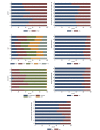Determinants of follow-up participation in the Internet-based European influenza surveillance platform Influenzanet
- PMID: 24613818
- PMCID: PMC3967126
- DOI: 10.2196/jmir.3010
Determinants of follow-up participation in the Internet-based European influenza surveillance platform Influenzanet
Abstract
Background: "Influenzanet" is a network of Internet-based platforms aimed at collecting real-time data for influenza surveillance in several European countries. More than 30,000 European volunteers participate every year in the study, representing one of the largest existing Internet-based multicenter cohorts. Each week during the influenza season, participants are asked to report their symptoms (if any) along with a set of additional questions.
Objective: Focusing on the first influenza season of 2011-12, when the Influenzanet system was completely harmonized within a common framework in Sweden, the United Kingdom, the Netherlands, Belgium, France, Italy, and Portugal, we investigated the propensity of users to regularly come back to the platform to provide information about their health status. Our purpose was to investigate demographic and behavioral factors associated with participation in follow-up.
Methods: By means of a multilevel analysis, we evaluated the association between regular participation during the season and sociodemographic and behavioral characteristics as measured by a background questionnaire completed by participants on registration.
Results: We found that lower participation in follow-up was associated with lower educational status (odds ratio [OR] 0.80, 95% CI 0.75-0.85), smoking (OR 0.64, 95% CI 0.59-0.70), younger age (OR ranging from 0.30, 95% CI 0.26-0.33 to 0.70, 95% CI 0.64-0.77), not being vaccinated against seasonal influenza (OR 0.77, 95% CI 0.72-0.84), and living in a household with children (OR 0.69, 95% CI 0.65-0.74). Most of these results hold when single countries are analyzed separately.
Conclusions: Given the opportunistic enrollment of self-selected volunteers in the Influenzanet study, we have investigated how sociodemographic and behavioral characteristics may be associated with follow-up participation in the Influenzanet cohort. The study described in this paper shows that, overall, the most important determinants of participation are related to education and lifestyle: smoking, lower education level, younger age, people living with children, and people who have not been vaccinated against seasonal influenza tend to have a lower participation in follow-up. Despite the cross-country variation, the main findings are similar in the different national cohorts, and indeed the results are found to be valid also when performing a single-country analysis. Differences between countries do not seem to play a crucial role in determining the factors associated with participation in follow-up.
Keywords: Internet; influenza; participatory surveillance.
Conflict of interest statement
Conflicts of Interest: None declared.
Figures



References
-
- Smith B, Smith TC, Gray GC, Ryan MA, Millennium Cohort Study Team When epidemiology meets the Internet: Web-based surveys in the Millennium Cohort Study. Am J Epidemiol. 2007 Dec 1;166(11):1345–54. doi: 10.1093/aje/kwm212. http://aje.oxfordjournals.org/cgi/pmidlookup?view=long&pmid=17728269 - DOI - PubMed
-
- Turner C, Bain C, Schluter PJ, Yorkston E, Bogossian F, McClure R, Huntington A, Nurses and Midwives e-Cohort Group Cohort Profile: The Nurses and Midwives e-Cohort Study--a novel electronic longitudinal study. Int J Epidemiol. 2009 Feb;38(1):53–60. doi: 10.1093/ije/dym294. http://ije.oxfordjournals.org/cgi/pmidlookup?view=long&pmid=18202083 - DOI - PubMed
-
- Mikkelsen EM, Hatch EE, Wise LA, Rothman KJ, Riis A, Sørensen HT. Cohort profile: the Danish Web-based Pregnancy Planning Study--'Snart-Gravid'. Int J Epidemiol. 2009 Aug;38(4):938–43. doi: 10.1093/ije/dyn191. http://ije.oxfordjournals.org/cgi/pmidlookup?view=long&pmid=18782897 - DOI - PMC - PubMed
-
- Nutrinet. [2013-10-08]. https://www.etude-nutrinet-sante.fr/fr/common/login.aspx.
Publication types
MeSH terms
Grants and funding
LinkOut - more resources
Full Text Sources
Other Literature Sources
Medical

